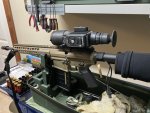Here are the "on paper" comparisons I've done in previous posts ...
So the trijicon "lens sizes" are focal length. So assuming the halo "lens sizes" are also focal length (most of the thermal lens size we see are focal lenth) ... we see the halo 50mm list price matches up with the mk3 35mm price ... and half way between the price for the reap 20mm and the reap 35mms.
Whereas the halo 25mm price matches the hunter 19mm price and is $500 lower than the reap 19mm price. So using focal length as a yard stick, the halo list prices buy you slightly more focal length than the trijicon list prices.
Both seem to have pvs-14 eye pieces.
Both have the same 12 micro oasys cores.
The reap weight range runs 16 to 32 oz
The mk2/3 weight range runs 30 to 37 oz
The halo weight range runs 20 to 28 oz
The reaps have a joystick interface
The mk2/3 have a turret interface
The halos have a button interface (and note most of the military thermals I can think of also have button interface)
The new reaps have a verticle battery compartment (mitigate possible recoil issues with inline battery compartments)
We cannot be sure about the halo batt compartment orientation yet
The mk2/mk3 have 3 batts
The reap2 have 2 batts
The halos have 4 batts
All are fixed focus
The trijicons are metal housings
The halos are polymer
the halos optical magnification ranges are 1.75x to 3.5x
the reaps and mk2/mk3s optical magnification ranges are 1.5x to 4.5x
Intangibles
The trijicons (irds) have been in the market for hum 4+ years ... and while n-vision optics is not a new player in the nv/thermal space, these units, making thermals with oasys cores, is a relatively new activity for n-vision optics.
Trijicons customer service is I think better known to the commercial space than n-vision optics. We know trijicon can response to customer issues.
At least within the mk2/mk3 line, there is an upgrade path from the lowest unit, the mk2 19mm to the highest the mk3 60mm ...
==
As to street pricing, the trijicon street pricing is fairly well known to those who pay attention. The n-vision optics street pricing for these new units is unknown, but based on the Atlas street pricing from last year, the discounts were not huge and availability was not plentiful.
Will n-vision optics be ramping up production this year ?
Will demand drive higher production levels ?
Will demand delay the onset of lower street pricing ? (why offer discounts in the face of demand which exceeds supply) ?
Will there be introductory pricing to "buy" market share away from trijicon ?
==
Well those are some thoughts ... the good news is the n-vision optics seem to be trying to enter the commercial thermal field with a strong line up ... oasys cored thermals with pricing which at least at list levels, seems slightly lower than trijicon pricing.
We await further developments !!!
(And I think it is great sign that an n-vision optics person came to visit with us !!!)





